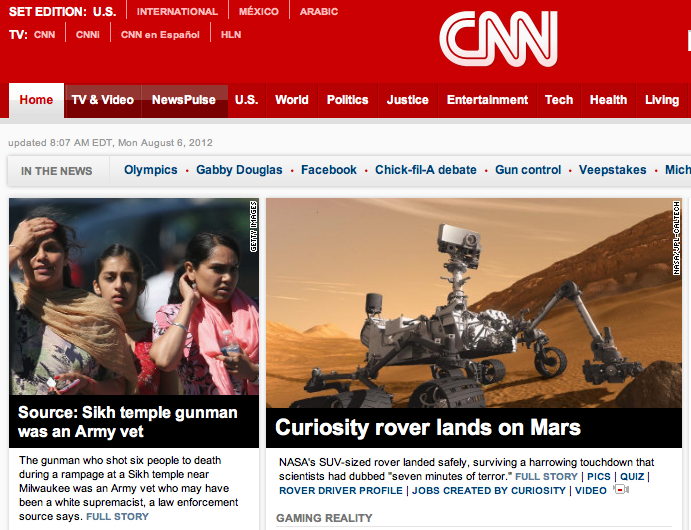Theoretical Math! What is it good for? Absolutely everything!Thu, 23rd Aug '12, 3:15 pm::
We are all accustomed to electronics getting cheaper and smaller over time, as if companies magically shrink down their components. We just assume that smart folks in white coats inside R&D labs turn on their supercomputers and swipe away on their 4D neural network interfaces really really hard and suddenly the bulky, costly components within all electronic devices can be replaced with a cheaper, smaller parts. In reality, each and every change from a larger part to smaller part is made possible by scientific breakthroughs in physics, material science, and sometimes even math.
Do you remember cellphones from a decade ago? With their pointy antennas and bulky size? What happened to that antenna? Math happened! Or in this case, space-filling curves. Most people have seen fractals - they are shapes that can be subdivided into parts, each of which is (at least approximately) a smaller copy of the whole - the more you zoom in, the more complex the design gets. While they make cool desktop wallpapers, most people don't think much about them. Turns out, their intrinsic self-similar design makes some of them (called space-filling curves) a perfect shape to capture electromagnetic signals, specifically wideband and multiband radio signals.
So instead of pointy antennas, cellphones now have tiny, embedded fractal antennas in them. These antennas can operate with good-to-excellent performance at many different frequencies simultaneously due to their fractal shape. Instead of inventing a brand new material or industrial process to shrink down the size of the antenna, scientists applied math to figure out the best shape for a really tiny antenna that can still get good reception.
The best part? The specific space-filling curve used in fractal antennas is called a Minkowski Island, named after the 19th century German mathematician Hermann Minkowski, one of Albert Einstein's teachers. Minkowski realized that the special theory of relativity, introduced by Einstein in 1905, could be best understood in a four dimensional space, now known as "Minkowski spacetime", in which time and space are not separated entities but intermingled in a four dimensional space-time. So not only did Minkowski help make GPS, in-car navigation, and science fiction about breaking the space-time continuum possible, application of his theoretical studies in fractals now makes it possible for people to have good cellphone reception without pointy antennas. Take that Edison!
While it is easy to understand why applied sciences and engineering disciplines need to be funded and studied, it is harder to justify the study of abstract theories because practical applications can take decades or even centuries! After all, why should you care that topologically speaking, a coffee mug is the same thing as a donut (or a ring)? Today, you may not. In twenty years, application of topology in 3D printing could revolutionize the entire manufacturing industry around the world.
KType FreeSun, 12th Aug '12, 7:25 pm::
After months of coding, I finally released KType Free. If you have an iPad, you should download it right away. The free version is identical to KType Pro, except for the voice quality. For KType Free, I used the freely available OpenEars library which embeds the CMU Flite text-to-speech engine. For KType Pro, released over six months ago, I licensed a commercial text-to-speech engine that offers realistic human voices.
With the release of KType Free, I'm hoping that those who cannot afford the cost KType Pro's superior audio quality, can still benefit from all the other features that KType offers. Additionally, now people can try out the KType interface at no cost and if they like it, upgrade to the Pro version for better voice quality.
It's been less than a day since KType Free has been available on the Apple iPad AppStore and I've already got tons of downloads and emails from potential users! Over the next few weeks, I want to make tutorials and get in touch with more potential users.
Thu, 9th Aug '12, 6:30 pm::
For the first time in my life, I solved a Rubik's Cube! I used the algorithm described here. Now, I practice.
The worst and the best of humanity summed up in a single front-page imageMon, 6th Aug '12, 8:25 am::
In a span of just twelve hours yesterday, I witnessed the worst of humanity in the form of bigoted hateful violence against innocent civilians and the best of humanity when NASA's MSL / Curiosity rover finally landed on MARS after flawlessly executing the most complex landing sequence ever devised.

This is why 3D printers are awesomeSat, 4th Aug '12, 2:20 am::
Thu, 2nd Aug '12, 11:10 am::
In a little over three days, NASA's one-ton Curiosity rover will land on Mars. Though the world is pretty blasé about machines landing on other worlds and trotting about year after year, Curiosity's risky maneuver during the final seven minutes of landing is so extraordinary, it seems utterly impossible. Here's a video explanation of what the final "seven minutes of terror" of the Mars Curiosity landing will be.
